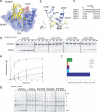Swapping small ubiquitin-like modifier (SUMO) isoform specificity of SUMO proteases SENP6 and SENP7
- PMID: 21878624
- PMCID: PMC3195590
- DOI: 10.1074/jbc.M111.268847
Swapping small ubiquitin-like modifier (SUMO) isoform specificity of SUMO proteases SENP6 and SENP7
Abstract
SUMO proteases can regulate the amounts of SUMO-conjugated proteins in the cell by cleaving off the isopeptidic bond between SUMO and the target protein. Of the six members that constitute the human SENP/ULP protease family, SENP6 and SENP7 are the most divergent members in their conserved catalytic domain. The SENP6 and SENP7 subclass displays a clear proteolytic cleavage preference for SUMO2/3 isoforms. To investigate the structural determinants for such isoform specificity, we have identified a unique sequence insertion in the SENP6 and SENP7 subclass that is essential for their proteolytic activity and that forms a more extensive interface with SUMO during the proteolytic reaction. Furthermore, we have identified a region in the SUMO surface determinant for the SUMO2/3 isoform specificity of SENP6 and SENP7. Double point amino acid mutagenesis on the SUMO surface allows us to swap the specificity of SENP6 and SENP7 between the two SUMO isoforms. Structure-based comparisons combined with biochemical and mutagenesis analysis have revealed Loop 1 insertion in SENP6 and SENP7 as a platform to discriminate between SUMO1 and SUMO2/3 isoforms in this subclass of the SUMO protease family.
Figures





References
-
- Hershko A., Ciechanover A. (1998) Ann. Rev. Biochem. 67, 425–479 - PubMed
-
- Kerscher O., Felberbaum R., Hochstrasser M. (2006) Annu. Rev. Cell Dev. Biol. 22, 159–180 - PubMed
-
- Geiss-Friedlander R., Melchior F. (2007) Nat. Rev. Mol. Cell Biol. 8, 947–956 - PubMed
-
- Johnson E. S. (2004) Annu. Rev. Biochem. 73, 355–382 - PubMed
-
- Mukhopadhyay D., Dasso M. (2007) Trends Biochem. Sci. 32, 286–295 - PubMed
Publication types
MeSH terms
Substances
LinkOut - more resources
Full Text Sources
Molecular Biology Databases
Research Materials

